April
The Latin Aprilis comes from aperire ‘open’, meaning that
April opens the doors for spring.
For that reason folk lexicon also has the name “colorful”
for April.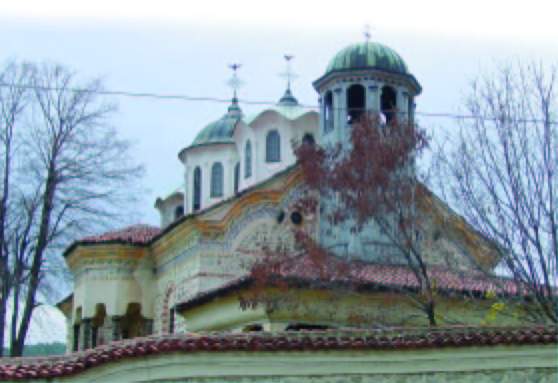
2 April. Nameday of Zhivko, Zhivka (from ‘live’, apothropic name).
3 April LAZAROVDEN (St. Lazarus’ Day)
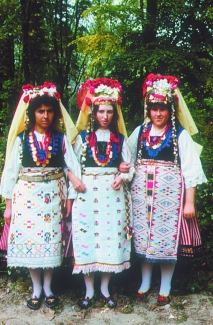 The
Saturday before Palm Sunday, a week before Easter, is Lazaritza. Old people
believe that Lazarus is the master of woods
The
Saturday before Palm Sunday, a week before Easter, is Lazaritza. Old people
believe that Lazarus is the master of woods
and bushes and helps people clear them and turn them into plough land.
That is why in folklore Lazarus carries an ax. St. Lazarus’ Day
is connected with the ritual called “lazarouvane”, an old
spring ritual for young girls. But in Thrace the girls perform the ritual
on the next day – on Palm Sunday, and the Saturday is called “Gypsy
Lazar” because the houses are visited by small children and gypsies
to collect small
presents. The name Lazar comes from Eleazar ‘God helps’.
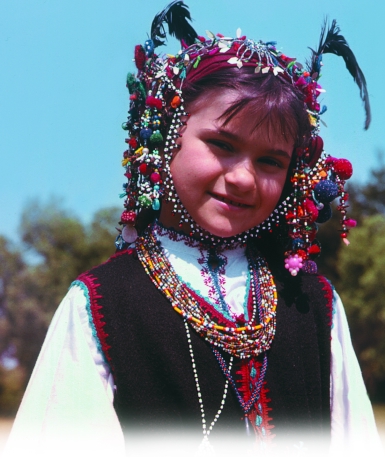
4 April TZVETNITZA (Palm Sunday) (Vrabnitza)
On this day young girls perform the
“lazarouvane” ritual. The legend tells that:
“In a small village in Thrace – Chitalovo,
they organized a big fair. Once from the next village of Kurtalan a lass
named Ruzha set out with her mother and father to visit the fair. After
walking for some time the girl felt thirsty and asked her father permission
to go to the dragon well and drink some water. “Don’t go,
wait until we get to the village!” her father said. “This
is a bad place.” But the girl didn’t listen and went out of
the way to the well. As she bent down to drink water, there came a dragon,
who asked her to become his bride. “You will be rich, very rich,”
he went on. But Ruzha was frightened and ran away to catch up with her
father and mother. She didn’t say anything to them.
They went to the fair. The girls were singing, but Ruzha looked sad –
she was thinking about the dragon’s proposal. She wanted to be rich and live in a palace. When the fair was over, she
left her parents and
She wanted to be rich and live in a palace. When the fair was over, she
left her parents and
went back to the well. Then she eloped with the dragon, became his 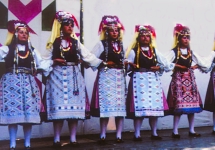 bride
and lived in the dragon’s palace. Years passed. She felt sick for
home and her kin and asked the dragon to let her go and visit her family.
The dragon agreed and left her on the same day and at the same well. Then
he flew away. During the years she had spent with the dragon she had grown
a dragon’s tail and decided first of all to get rid of it. She turned
and tried to bite off the tail but didn’t succeed. She turned to
the other side and tried to catch her tail but failed again. Then she
started throwing herself about but to no avail. She heard the songs of
the girls who were coming back from the fair. Bloody foam appeared on
her lips
bride
and lived in the dragon’s palace. Years passed. She felt sick for
home and her kin and asked the dragon to let her go and visit her family.
The dragon agreed and left her on the same day and at the same well. Then
he flew away. During the years she had spent with the dragon she had grown
a dragon’s tail and decided first of all to get rid of it. She turned
and tried to bite off the tail but didn’t succeed. She turned to
the other side and tried to catch her tail but failed again. Then she
started throwing herself about but to no avail. She heard the songs of
the girls who were coming back from the fair. Bloody foam appeared on
her lips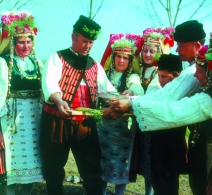 but the darn tail was still in place. Horrified that her friends will
see her this way, her heart burst. The girls found her, buried her and
from that day on every year they gathered round the well. And they danced
the horo, not in a ring but in the form of a snake to remember young Ruzha
the dragoness. The dance was called “buenetz” and the girls
were called “lazarki”. Lazarouvane holds an important place
in the ritual system of the patriarchal Bulgarian village. Through it
people express their need to act upon the positive development of
but the darn tail was still in place. Horrified that her friends will
see her this way, her heart burst. The girls found her, buried her and
from that day on every year they gathered round the well. And they danced
the horo, not in a ring but in the form of a snake to remember young Ruzha
the dragoness. The dance was called “buenetz” and the girls
were called “lazarki”. Lazarouvane holds an important place
in the ritual system of the patriarchal Bulgarian village. Through it
people express their need to act upon the positive development of
things. We can discover in it traces of the pagan holidays of Thracians
and proto- Bulgarians, connected with the waking of nature for a new life
after the frosty winter days and the coming of spring. Lazarouvane is
a ritual practiced only by
young girls who have reached sexual maturity. Their participation is imposed
by patriarchal society, for in order to be permitted to have marital relations
girls had to have performed this ritual. Their participation in
the ritual is the highest point in their socialization. The lazarouvane
is a complex of ritual acts, ritual dress, ritual songs and ritual dances.
The young girls perform an open horo dance, which is lead by the boyanitza”,
also called in some places “kumitza” or “godmother”.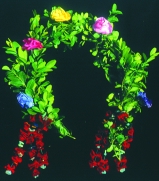 This role is given to the most prominent girl in the village, respected
and liked by all. She has an important part in the ritual – while
the girls are dancing and
This role is given to the most prominent girl in the village, respected
and liked by all. She has an important part in the ritual – while
the girls are dancing and
singing in the yard of the house, she goes to the hostess and puts a scarf
on her right shoulder and expects presents from her as well – white
eggs, cheese, flour, nuts, dried fruit and small coins. The boyanitza
must
know the right songs for every house. For the songs vary widely: about
the man of the house, about the woman of the house, about the children,
about an unmarried man or woman. They are all in praise of love, marriage,
the family and expectations for children in the future. After the lazarouvane,
girls and young men do the "razkumichvane" – the “lazarki”
place their wreaths on a wooden paddle, then they are dropped in
running water and whose wreath comes first will be the first to marry
this year. The nameday of Kalina, Violeta, Bozhura, Vurban, Tzvetan, Tzvetana,
Kamelia, Nevena, Margarita, Lilyana, Yavor, Yasen – people named
after flowers and trees.
5 April VELIKI PONEDELNIK (Good Monday)
The week before Easter is called by Bulgarians “Great” or
“Passion Week” and it is related to a number of restrictions
and prohibitions. During the whole week people must not sing songs, except
religious ones,
they don’t dance and there is no music. The one who does not obey
these rules will have a boil on his bottom. On this day begins the great
Easter cleaning.
6 April VELIKI VTORNIK (Holy Tuesday)
On this day young girls and brides go to get “silent” water. This is fresh water brought from three sources and no one must utter a word. Such ritually purified water is taken to have healing properties. Then they wash their heads for health with “silent” water from the bucket.
7 April VELIKA SRYADA (Holy Wednesday)
On this day women do not do women’s work – they don’t sew, they don’t spin or weave. Children pick wild geranium, make nosegays and prepare for the coloring of the eggs on the next day.
8 April VELIKI CHETVARTAK (Sweet Thursday)
 of
the Jews said that Jesus will rise on the third day. The host didn’t
agree: "When the
of
the Jews said that Jesus will rise on the third day. The host didn’t
agree: "When the
chicken on the table rises and the eggs become red, he will also rise!"
That very
moment the eggs changed their color and the chicken became alive. The
practice of coloring eggs in our lands is borrowed from the Slavs in the
second half of the 5th and the beginning of the 6th c. In Western Bulgaria
the colored eggs are called “perashki”. Some scholars think
that the name “perashka” is a derivative of the Old Slavic
word per meaning ‘beat, strike, hail, thunder’ and originated
from the still older word kver meaning ‘oak-tree’, which gave
rise to the name Perun – the name of the god of thunder. What is
more, in the ancient lands of the Bulgarians Thursdays were celebrated
as days protecting against thunder and hail. Because Thursday was the
day of Perun. The name Perundan (‘Perun’s day’) has
the meaning of "Thursday" in the language of Polab Slavs. This
explains the long-standing tradition to dye the eggs on Thursday. The
woman of the house dyes the eggs and the first two are always red. They
are the
freshest, taken out of the laying-place early in the morning. They have
healing properties. The first one is placed by the icon and on the next
year it is buried in the first furrow in the field. With the second egg
the woman rubs the face of every child for health and then she hides it
to heal people and animals.
In a manuscript from the 10th c., kept in the “St. Anastasius”
monastery near Thessalonike, it is said: “The Christian ritual of
giving colored eggs exists since the time of the apostles and originates
from St. Mary
of Magdalene. She, according to legend, on coming to Rome, presented herself
to the Emperor Tiberius, gave him a red egg and said: “Christ has
risen!” In this way she declared her faith. And the Christians began
imitating her. Another legend tells that after Christ’s death seven
Jews got together for a feast. On the table there was roast chicken and
hard-boiled eggs. During the feast one In old times the dying of
Easter eggs was practiced primarily in the villages. It was not typical of the towns.
Exceptions were the
practiced primarily in the villages. It was not typical of the towns.
Exceptions were the
engravings of the monks from the larger Bulgarian monasteries. Otherwise
the dying
and painting of the eggs was the responsibility of young and old women
alike and was
done also on Saturday, but secretly so that no evil eye spoils the eggs.
The most widely used dye in the past was the red one, prepared from boiled
plants. In the Rhodope Mountains they also used infusion of the dried
insect “koshenil” or leaves of marjoram picked at Midsummer
Day. They used a special cutter, “pen” with wax and bone-glue.
The “pen” is made from a small hollow tube of dry elder or
cane with a nib made from a rolled and sharpened silver coin. The ornaments
on the dyed Easter eggs include plant motifs, interwoven with solar
swastikas, zoomorphic drawings of butterflies, fish, chickens, stylized
forms of snakes and spiders, as well as geometrical and schematic anthropomorphic
images. Naturally, the woman who decorates the eggs never forgets to encode
the orthographic elements of the folk greeting "Christ has risen”.
9 April VELIKI PETAK (Good Friday)
People also call it “Crucified Friday”. This is a great holiday.
People don’t work for they believe that if anyone breaks the taboo
the fields will be destroyed by heavy hail. On this day in some regions
the young girls draw with coal and pens the eggs dyed on Thursday. A legend
tells that on Friday, when Christ
was ascending the hill with the enormous cross on his back, he passed
by a woman who was washing. He asked her for some water to moisten his
dried lips. She took some of the slosh and gave it to him. He
drank it but said nothing. Further on from a house in which people were
baking bread they gave him a piece of hot bread. When he climbed the hill
Christ said: “Let a woman who washes on this day be damned and let
he who bakes bread be blessed!” That is why no one must wash on
Friday and young girls
and women make Easter dolls and breads. But before that they make fresh
yeast, for Easter buns are made with new yeast. In the past all houses
had yeast, for if someone lost the yeast the house remained bare and without
fruit during the whole year. The fleshing up is done not by putting old
yeast in the
dough but by leaving it in a warm place to turn sour. From this yeast
they make the ritual breads and keep some for the next baking of bread.
Ritual Easter breads are different – round, with a hole in the middle,
elliptical or in the shape of a pleat. But everywhere people put red eggs
in them. These ritual breads are
always made by married young, clean women and from wheat flour. The flour
is sifted three times and during the souring of the dough fresh picked
green leaves are put in it – nettle or wild geranium.
10 April VELIKA SABOTA (Holy Saturday)
The Bulgarians call it also “Odushna” or “Pogrebenna” for on this day the women usually visit the graveyards. They pour wine and smoke incense, light candles, give out dyed eggs, boiled wheat and bread for the souls of the dead relatives. In some villages on Saturday evening they take the yarn off the distaffs for more rain and fertility.
11–13 April VELIKDEN (Easter)
(Passover)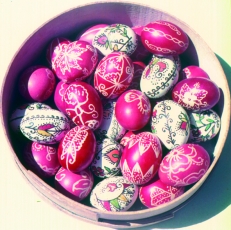
“Oh, Easter – Sun, Life is a chicken – red and motley,
Hatched by you!” (folk song) Easter, or also called Pasha (from
Hebrew,
meaning ‘passing over’), is a holiday that has its origin
in antiquity. Roaming nomadic, Semitic and Thracian tribes celebrated
it, rejoicing in spring, in the revival of nature and life. With the emergence
of Christianity the holiday is connected with the resurrection of Jesus
Christ and this is why at first the holiday of Jews and Christians coincided.
But in 325, the year of the Nicean Council, a decision was taken to celebrate
Easter on the first Sunday after the vernal equinox. That is why until
now the holiday has no fixed date in the calendar. The three great days
are celebrated during the time between April 4 and May 8.
An ancient legend tells that many years ago, when God walked on earth
among the people and healed them, there was a kingdom in which there lived
an evil sorcerer. He locked the water and the sun in a deep cave with
nine padlocks. Many years passed. People worked from morning till night
but earth bore no fruit without water and light. The grass dried, animals
died, birds disappeared. People lived in small dark houses overgrown with
weeds, which they used for food… They forgot their traditions and
became so malicious that they incessantly fought among themselves. In
a little hut, tucked away in the mountain, there lived a young man with
two children – a girl and a boy. The evil sorcerer had taken away
the mother by force to his palace to serve him. The winter was hard, frost
and cold bound the earth. Spring came and one day the father went to the
forest for fresh
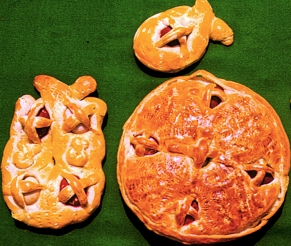 On
the very moment the whole Earth shone bright. From that light the sorcerer
got blind. He lost his power and was turned into a small black beetle.
The people broke the padlocks and freed the water and the sun. The celestial
body rose high and shone over the entire Earth. The water ran down the
mountain, babbled merrily and flooded the forest, the fields and the plains.
The trees covered with green leaves, the birds and the animals came back
to where they lived and the earth came to life again.” From that
time on people dedicated this day to Grandfather Easter. They dye red
eggs and celebrate the new-born nature. “Easter is not Easter without
a red egg!” people say. The practice of dying eggs for Easter is
as old as the holiday itself. In folk legends the egg is seen as a symbol
of life, of renovation, of resurrection for new life. That is why all
ancient mythologies have the belief that “the whole world”
was born from
On
the very moment the whole Earth shone bright. From that light the sorcerer
got blind. He lost his power and was turned into a small black beetle.
The people broke the padlocks and freed the water and the sun. The celestial
body rose high and shone over the entire Earth. The water ran down the
mountain, babbled merrily and flooded the forest, the fields and the plains.
The trees covered with green leaves, the birds and the animals came back
to where they lived and the earth came to life again.” From that
time on people dedicated this day to Grandfather Easter. They dye red
eggs and celebrate the new-born nature. “Easter is not Easter without
a red egg!” people say. The practice of dying eggs for Easter is
as old as the holiday itself. In folk legends the egg is seen as a symbol
of life, of renovation, of resurrection for new life. That is why all
ancient mythologies have the belief that “the whole world”
was born from
an egg. One of the first mentions of the world egg can be found in the
ancient Egyptian manuscripts from the period of the New Kingdom (14–11
c. BC). According to it, God Tot was born out of an egg in the
town of Hermopolis (near Cairo). In the “Book of the Dead”,
chapter 85 relates how eight gods from Hermopolis originated from the
world ocean Nune and created the primeval egg from which, in the form
of a bird, the Sun appeared. And in the “Texts of the Sarcophagi”
we find the story of the egg of Osiris. In it were Osiris and Set, who
were brothers, but the one was an incarnation of good and the other –
an incarnation of evil. The myth indicates that the origin of good roots.
There he cut a wooden egg, dyed it
with red soil and decided to take it to his children to play with it.
When he returned home the children were asleep and he put the red egg
next to their heads so they would see it when they wake up in the morning.
He also went to sleep. During the night an old man with a white beard
came to him and warned him that on
the next day his house will be visited by the evil sorcerer to take away
his two children. “But don’t you worry,” the old man
said, “hold the red egg in your hand!” He said that and disappeared.
This old man was Grandfather Easter. On the next day, in a carriage drawn
by a three-headed dragon, the sorcerer arrived with fire and thunder and
stopped in front of his house. The father was horrified and hugged his
children tightly in this arms. The red egg rolled by the heads of the
children and shone like a small sun. The father remembered the advice
of the good old Easter. He grabbed the egg in his hand and held it high
above his head and evil is one and the same. During the Middle Ages the
egg symbolized the four
elements of the universe: the shell symbolized the Earth, the membrane
– the air, the white symbolized the water, and the yolk –
the fire. In mythology and in everyday practice life and death are always
interrelated.
That is why the egg has become the symbol of both life and death. In the
museum of folk tradition in Basel (Switzerland) they keep the costume
of Death, decorated with garlands of eggshells. And in one of the museums
in Milan there is a painting by Piero Franchesca from 1472 of Virgin Mary
with the infant
above whom is an egg – the symbol of death and eternal life and
of hope. May be this is the reason why in some regions of Bulgaria the
mummers are lead by an old man carrying an egg. For the mummers “die”
to come to life again with nature, with the hope for tomorrow’s
prosperity. The Easter bread is the second basic symbol of this day. It
is never cut but broken by the oldest person in the house into as many
pieces as there are members of the family and one piece is left for God
as well. After the traditional meal comes the time for songs, the ring
horo dances and the “swinging”. Every young girl must “swing”
not to be loved by the dragon, to be healthy and be loved by the young
men.
11 April. Nameday of Veliko, Velichka (from “velik” (great), a protective name)
18 April TOMINA NEDELYA (St. Thomas’ Week)
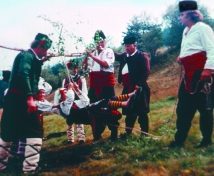 The
week after Easter is called St. Thomas’ Week, after the name of
one of the twelve apostles of Jesus. The legend tells that Thomas didn’t
believe in Christ’s resurrection and for that reason the Savior
appeared
The
week after Easter is called St. Thomas’ Week, after the name of
one of the twelve apostles of Jesus. The legend tells that Thomas didn’t
believe in Christ’s resurrection and for that reason the Savior
appeared
before him after a few days and allowed Thomas to put his finger in his
wounds. That is why the apostle is called Doubting Thomas. This week is
full of young girls’ holidays, most important among which is the
celebration of the Holy or Empty Wednesday. In
many villages on this day maidens play the “Mara-Lishanka”.
They make a bride-doll out of the slippers of a young bride who was married
during the winter (one is yellow and the other one red). They dress the
doll in a man’s shirt and this shirt is the sign suggesting
that this is the proto-image of the great bisexual (androgynous) divinity
from whom man originated, according to Bulgarian folk mythology.